Top News
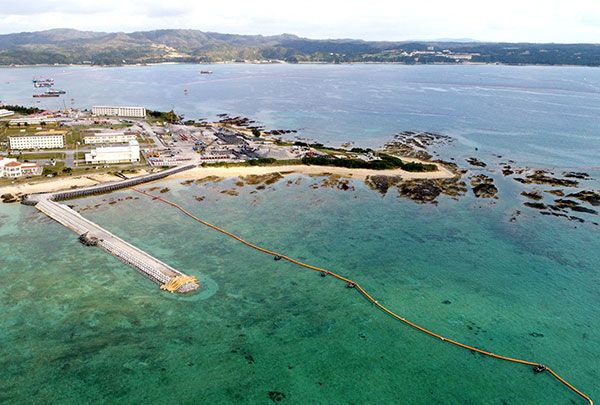
January 26, 2016 Ryukyu Shimpo
By Shohei Tsukazaki
The Nago Board of Education (BoE) and the Okinawa BoE decided January 25 to conduct a cultural asset survey starting in February on the land portion of the “Nagasaki Kaneku Scattered Artifact Zone” located at the tip of the Henoko Peninsula (and surrounding water) inside the U.S. Marine’s Camp Schwab, where new base construction continues.
The scattered artifact zone is adjacent to where the U.S. military is planning to build their N3 and N4 seawalls being built to aid land reclamation.
If the survey were to take a long time to complete, or if archeologically significant findings were made, if has the potential to affect the ongoing construction.
According to the Cultural Assets Preservation Act, no construction can be done within the area encompassing the scattered artifact zone until the survey is complete.
The Nago BoE is currently “in the process of scheduling” the survey.
If the survey were to turn up relics such as village remains, according to the aforementioned preservation law the Okinawan Defense Bureau (ODB) and Nago City, tasked with carrying out the survey, are required to discuss whether or not they are to be preserved, and how to best handle them.
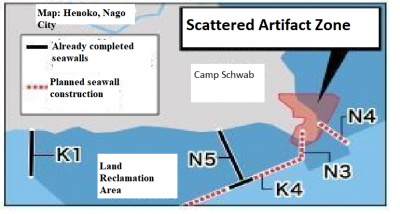
Henoko, Nago City
― Already completed seawalls
—- Planned seawall construction
Scattered Artifact Zone
Camp Schwab
Land Reclamation Area
The survey on the land portion of the artifact-containing area is the first since it was designated an archeological site in July of 2016.
The Nago BoE has also been conducting a similar survey in the water portion of the artifact zone, which overlaps with the area designated for reclamation as part of the base construction, since last April.
With regards to the construction plans in the adjacent area, the ODB went no further than to comment that, “We plan to suitably handle these cultural assets in conjunction with the local BoE, based on the results of the survey and in adherence to all laws and regulations.”
The Okinawa BoE recognized the scattered artifact zone as the 8th site within Camp Schwab in July, 2016. Prior to its designation, a survey conducted by Nago found pottery fragments from the early-modern Ryukyu era (1609-1879) and late-modern era in the area around the artifact zone.
They also discovered a Ryukyu Dynasty-era “anchor stone,” for the first time off of Okinawa’s east coast.
Shoijn Heshiki, head of the Okinawa BoE, said, “Based on the rules set out in the Cultural Assets Protection Act, I want the survey to proceed with objectivity.”
(English translation by T&CT and Sam Grieb)
Go to Japanese

January 20, 2018 Ryukyu Shimpo
On January 16, a get-together was held between the Watoto Children’s Choir and children from Uruma City at the Akamichi Community Center.
The Watoto Children’s Choir is a choir group from Uganda, Africa that cares for orphaned children and women that have been abused.
On the following day, there was a first ever concert in Okinawa by the Watoto Children’s Choir at the Uruma Shimane Art Theater.
The Okinawa Watoto Executive Committee and the Akamichi Residents’ Association organized this get-together.
They want to instill hope in the Uruma children through cultural exchange.
During the get-together, the Watoto choir performed song and dance, while from the children from Okinawa performed their powerful Eisa dance.
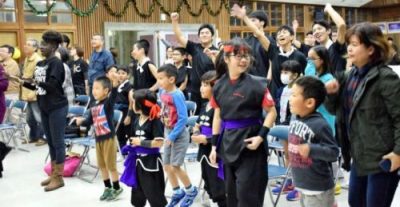
Participants dancing in tune with the Watoto Choir’s song.
The Watoto Children’s Choir was established in 1994 at the Watoto Church in Uganda’s capital, Kampala.
The organization fosters the independence in children who have lost their parents and/or their homes due to AIDS, conflict, and/or war, along with women who suffer from abuse and do not have a place to work at.
With three hubs in three separate villages in Uganda, the Watoto Children’s Choir strives to establish a sense of community, along with promoting a better life through educational and medical means.
The Watoto has seven choir teams that travel and interact with children around the world via song and dance.
About 40 people comprised the Asian choir team this time and visited Okinawa for the first time.
Since September, this team has performed in Japan, Hong Kong, and Singapore for the past six months or so.
Asian team leader Ivan Bryan Byarugaba described the Watoto’s activities and the state of affairs in Uganda.
He said, “The kids here have been through a variety of experiences.
Through this cultural exchange, we want to share the children’s life stories.
” Chelty, age 12, who was unable to attend school due to her mother’s neglect, said she wants “to become a pilot” in the future. Since she and her mother have joined the Watoto, they have been receiving livelihood support and an education to become independent. She smiled and said that now “Mom has started to take care of me and I can attend school.”
During the get-together, Yusuke Maeshiro, who performed the Gushikawa Kasshin Taiko, felt that he was brought closer to the people because of the get-together.
He said, “Everyone was friendly and were easy to talk with.”
(English translation by T&CT and Chelsea Ashimine)
Go to Japanese

January 26, 2018 Ryukyu Shimpo
Between January 23 and 25, the four young men who vandalized Chibichiri-gama vistied the site with their probation officers as part of their probation program.
They assembled Buddha statues by attaching face and arm pieces that the bereaved family members and Minoru Kinjo had prepared beforehand, and set up these 12 statues around Chibichiri-gama.
Over these three days, they also put their hands together in prayer for the deceased in the cave.
On January 25, the four young men cleaned up Chibichiri-gama in Namihira, Yomitan where residents were forced to commit suicide during the Battle of Okinawa.
With Kinjo, creator of the Statue of Peace Connecting Generations at the entrance to the cave, they also set up 12 new Buddha statues.
They listened to the stories about “collective suicide” (collective forced death) from the Bereaved Families Association, and learned about the biggest tragedy of the Battle of Okinawa and the importance of passing the story down.
According to Yonaha, head of the Bereaved Families Association, the young men apologized again and said they did not know the history and committed a significant wrongdoing.
They expressed their desire to make sure such a crime will not happen again in the future, and to pass down stories of the Battle of Okinawa.
Yonaha said they were nodding with serious expressions at the words of the bereaved families.
Yonaha told the four young men, “Since you set up the statues, I would like you to visit gama to put your hands together in prayer.”
He recalled, “The boys reflected on their past conduct and seemed to have changed through work.” Kinjo said, “I was happy to see they were working silently. I hope the boys will pass down the history of the Battle of Okinawa.”
In September last year, the four young men pulled apart the strings of paper cranes inside the cave and destroyed mementos and signboards.
They were arrested for property damage and put on probation.
The Statue of Peace at the entrance to the cave was also damaged.
The bereaved families are considering working together with the young men to repair it.
(English translation by T&CT and Megumi Chibana)
Go to Japanese

January 19, 2018 Ryukyu Shimpo
In response to consecutive emergency landings of U.S. Marine Corps helicopters, the Okinawa Prefectural Assembly held an extraordinary plenary session on the morning of January 19 and unanimously passed a protest resolution and opinion statement calling for suspension of Marine Corps Air Station Futenma’s operations by the end of February in 2019.
This is the first time that the Okinawa Prefectural Assembly has stated the deadline to call for suspension of MCAS Futenma.
The statement asserts that, “Prefectural residents must not be exposed to fear from military bases anymore.
The U.S. military, and the U.S. and Japanese governments should handle the current situation that has not improved at all with a sense of crisis and promptly do the utmost to eliminate the concerns of the prefectural residents.”
Additionally, the resolution calls for six items including (1) suspension of flight exercises by U.S. military aircraft stationed at MCAS Futenma over private lands, (2) suspension of operations on MCAS Futenma within five years (by the end of February 2019), (3) establishment of a special meeting council comprising the Okinawa Prefectural Government, the Japanese government, and the U.S. government as its three parties.
Photograph: On the morning of January 19 at the Okinawa Prefectural Assembly Hall, the Okinawa Prefectural Assembly unanimously passes a protest resolution and opinion statement after successive emergency landings of U.S. Marine Corps helicopters.
(English translation by T&CT and Megumi Chibana)
Go to Japanese
January 21, 2018 Ryukyu Shimpo
By Hiroko Sato, Style Editor
A shining cloud racing through the sky like a phoenix.
The Japanese Aerospace Exploration Agency (JAXA) successfully launched their small-engine Epsilon-3 rocket January 18.
A fantasy-like video of the launch showing the space-bound rocket and the shining cloud trailing it has gained a lot of attention.
The video of the launch was recorded and edited by filmmaker and star photographer Kagaya.
After capturing the launch, Kagaya uploaded the 13-second video to Facebook that afternoon; as of January 21, the video had over 760 shares and 39,000 views.
According to Kagaya, the video was taken from Ogimi village in the northern part of Okinawa’s main island.
The video was recorded by taking photos in continuous shooting mode using three mirrorless interchangeable-lens cameras (MILC), which were then linked together.
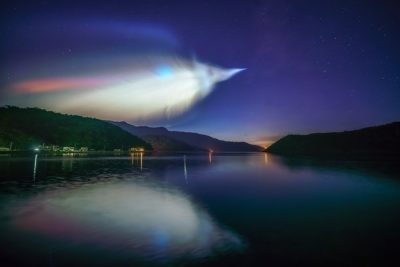
Racing through the air like a phoenix (Photo by Kagaya)
The photos were taken over a nine-minute window from 6:09-6:18 a.m., and were edited to play in sequence at 30-times normal speed, resulting in the 13-second video that was released.
“The afternoon before, I became excited once I made the decision to go,” said Kagaya. Despite being far away from the rocket’s launching point in Kagoshima, Kagaya thought, “I would be able to see the rocket’s ascension from the side,” and decided on watching and photographing the launch from the main island of Okinawa. After arriving in Okinawa, racing to the spot in a rental car praying for clear skies, the shoot was a success.
“It was the first time I had seen this kind of backdrop, so I ended up having to do a lot of adjusting on location.”
“The rocket flash was fairly bright, and even reflected off of the water.
Even though the colors weren’t as strong as they were in the photographs, when I saw it with my eyes I knew.
I could hear a whooshing sound coming from the direction of the rocket. Due to the distance from the rocket, the sound should have come quite a bit after, but I heard it right then. I’m not sure why.”
Now, please enjoy the magnificent, fantasy-like video of the Epsilon-3 rocket launch.
(English translation by T&CT and Sam Grieb)
Go to Japanese
January 18, 2018 Ryukyu Shimpo
The Japanese Ministry of Defense announced on the afternoon of January 18 that three U.S. military helicopters flew over Futenma Daini Elementary School in Ginowan City earlier that day.
It was the same elementary school where, in December of last year, a window dropped from a U.S. heavy transport helicopter onto the school’s exercise ground.
After the incident, the Japanese and American governments had agreed that the U.S. would, “Do everything within their capabilities,” to avoid the airspace over the elementary school.
This was the first flight over the same school’s airspace confirmed by the Japanese government since the agreement.
Meanwhile, the U.S. Marine Corps stationed in Japan, who operate the helicopters, have asserted that the helicopters did not fly over the elementary school, based on testimony from the pilots and radar tracking.
However, the Japanese Ministry of Defense released to media outlets footage taken from cameras placed at Futenma Daini Elementary School showing the airspace above the school as evidence.
(English translation by T&CT and Sam Grieb)
Go to Japanese

January 17, 2018 Ryukyu Shimpo
Visitors are thronging to Genka, Nago in Okinawa Prefecture to see the charming white plum blossoms in full bloom along the road in the Ohshittai wetlands area.
The plum trees were planted by local residents. Spectators took pictures and expressed their delight at the plum blossoms floating and dancing in the breeze as they fluttered to the ground.

Shigemi Nakazato, 58, who visited from Nakijin Village with her family of five on January 16, gazed at the plum blossoms with a smile on her face, saying, “We came after h
earing about them on the radio.
Each time we come they are beautiful, their lovely scent wafts in the breeze, and I feel so happy watching them together with my family in the glow of the sun.”
(English translation by T&CT and Sandi Aritza)
Go to Japanese
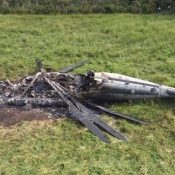
January 22, 2018 Ryukyu Shimpo
By Ayako Sakaguchi
It came to Ryukyu Shimpo’s attention on January 21 that toxic substances such as the carcinogen benzene are present on the site where a CH-53E U.S. military helicopter went up in flames and came to the ground in Takae, Higashi Village in October last year.
On January 11, the Okinawa Defense Bureau (ODB) explained this to the owner of the land upon which the incident occurred, 64-year-old Akira Nishime. However, the ODB did not provide any explanation about the levels of benzene or whether it was enough to affect the human body.
Immediately following the incident the ODB collected a soil sample from the site and examined it, but the results have not yet been officially announced to the Okinawa Prefectural Government (OPG) or media outlets.
According to Nishime, officials from the ODB came to his house on January 11 and explained that toxic substances such as benzene were identified at the accident site.
They said that due to the detection of toxic substances, 300 cubic meters of soil would be removed, dug out one meter deep.
Out of the 300 cubic meters of soil, 250 cubic meters will be treated in Okinawa, but the remaining 50 cubic meters cannot be treated in Okinawa and therefore will be transported to Osaka for treatment.
Nishime said, “They did not explain at all the level of soil contamination or if it would affect a human body.”
Immediately following the incident the U.S. military hauled away a large quantity of the soil, five trucks’ worth. The OPG and ODB collected and examined the soil remaining after this U.S. military haul.
(English translation by T&CT and Erin Jones)
Go to Japanese
January 19, 2018 Ryukyu Shimpo
On January 18 the residents’ liaison association to oppose militarization of Ishigaki held a citizens’ rally at Ishigaki Citizen Hall to ask that the Japan Ground Self-Defense Force (GSDF) not be deployed to Ishigaki Island.
According to the organizers about 400 people attended to fervently oppose the deployment.
Takao Izutsu, a representative of Veterans for Peace Japan (VFPJ), a group composed of former SDF officials and citizens, spoke at the rally.
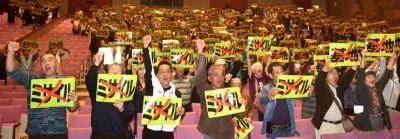
On January 18 at Ishigaki Citizen Hall, citizens rally against deployment of GSDF to Ishigaki Island
Izutsu said, “Speaking in terms of military logic, there are no wars in which bases are not targeted,” emphasizing the elevated risk of emergencies on the island that would come with GSDF deployment.
He went on to explain that in the case of an emergency it will be physically impossible for island residents to take shelter, and said, “Regardless of our support of or opposition to the deployment, we should take a hard look at the realities of war.”
At an exchange of opinions among city residents, the owner of an independent business in Hirae, Ishigaki CIty claimed, “We don’t want to be made to experience the damage from bases like that experienced by the families on Okinawa Island.” Kei Chinen, the general manager of Okinawa EXES Ishigakijima Hotel in Miyara, Ishigaki City, said, “Tourism is a peacetime industry. A stronghold that stirs up feelings of insecurity isn’t needed.”
A resolution was adopted at the rally. The resolution requested that the calculated expenses for this GSDF deployment included in the draft defense budget for fiscal year 2018 be removed.
(English translation by T&CT and Erin Jones)
Go to Japanese
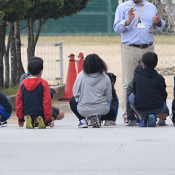
January 19, 2018 Ryukyu Shimpo
On January 18, the Futenma Daini Elementary School conducted an evacuation drill assuming a situation in which a U.S. military aircraft approaches the airspace over the school.
With evaluators stationed by the Okinawa Defense Bureau (ODB) present, the school representatives confirmed the evacuation routes and assembly points.
City Board of Education Guidance Section Manager Mitsugu Kanou angrily said, “It’s as if we’re back in wartime. It is deplorable how we must constantly worry about the sky above us.”
The school used the athletic field for the first time since the accident in which a window fell off a U.S. military helicopter into the same athletic field. Four classes participated in the drill.
Evaluators on the roof notified the evaluators in the athletic field of a simulated U.S. military aircraft approaching and told them to “Run” over a loudspeaker to facilitate the evacuation.
The children hustled from the athletic field to the assembly point.
Every year, Futenma Daini Elementary School conducts an evacuation drill assuming a U.S. military aircraft crashing.
But this was the first evacuation drill since the accident. Some students declined to participate.
While the school and the city board of education have been requesting that U.S. military aircrafts not fly over the school, both Japanese and U.S. governments have only said that the aircrafts “will not be flying to the maximum extent” and have not given a definite promise.
Regarding the drill, Section Manager Kanou said, “This is a situation that normally should not be happening” and emphasized that “A promise that they will not fly for 99.9% of the time still means there is a 0.1% chance that they will fly.
Conducting evacuation drills cannot be helped since it is to lessen people’s anxiety.”
(English translation by T&CT and Chelsea Ashimine)
Go to Japanese

January 13, 2018 Ryukyu Shimpo
Shanghai Hai Hua Shipping Company (HASCO), a Chinese maritime transport company, has begun operating international container ships on a route between Naha Port and Ho Chi Minh Port in Vietnam through Keelung Port in Taiwan. On January 18 the first ship to take this route will come in to Naha Port. This is the first direct distribution route that links Naha and Vietnam. Okinawa Kokusai Kaiun Company (OKK), which is based in Ishigaki City and acts as a shipping agent for HASCO, issued the following statement: “With the market expansion we anticipate from a direct route with Vietnam, we can bolster the advancement of Okinawan enterprise in East Asia.”
In 2005 HASCO and OKK opened a route connecting Shanghai, Naha and Taiwan. However, this new route extends operations of the 2005 route on the mainland China end to Lianyungang Port in Jiangsu Province, and on the south end to Vietnam. In addition, three cargo ships were added to the operations on this route, which goes from Lianyungang, to Shanghai, to Naha, to Keelung, to Ho Chi Minh, and then returns to Shanghai. The ships on this route come into Naha Port every Thursday.
According to OKK the demand in Vietnam for used paper and used construction machinery exported from Okinawa is high, and the leading imports will be clothing and miscellaneous goods. Before this route extension it would take about two weeks for Okinawan exports to be transshipped through a main port such as Shanghai and arrive in Ho Chi Minh. Through the direct voyage the shipping period of Okinawan exports to Ho Chi Minh Port is shortened to five days.
This is also the first time that Lianyungang Port in Jiangsu Province, China, has been connected by a direct route with Naha Port. Lianyungang produces agricultural goods, so Okinawan vendors are making inquiries about the import of fruits and vegetables.
The assistant manager of OKK’s Naha branch office said, “Now that Naha will be receiving northern regions’ goods from Shanghai, I also want to propose that we make use of the direct route with Vietnam to create a trend advancing Okinawan enterprise in Southeast Asia.”
(English translation by T&CT and Erin Jones)
Go To Japanese













 Webcam(Kokusai Street)
Webcam(Kokusai Street)


